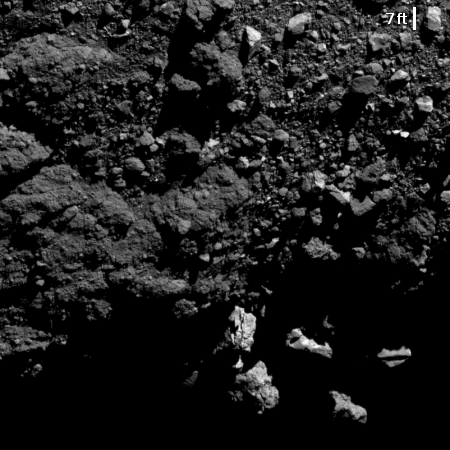Bennu from two miles
In late March OSIRIS-REx completed its fourth fly-by of the asteroid Bennu. The image on the right, cropped and reduced to post here, was taken when the spacecraft was only 2.1 miles above the surface. If you were standing among these large boulders, we could easily see you.
The image itself shows the asteroid’s southern limb, and thus the shadows are accentuated. This makes it easier to see surface details. Though it is clear once again that Bennu is a pile of boulders and rocks cemented together and floating in space, the photograph also shows that it also has areas where the material is either much larger or fused together more solidly, as shown by the more massive sections in the left center of this picture. We might be looking a very large boulders peeking up from below the surface, or possibly this is the hint of some real bedrock.
The OSIRIS-REx team is continuing the spacecraft’s survey phase, gathering high resolution images in order to compile a detailed map of the surface, prior to planning the touch-and-go sample grab.
On Christmas Eve 1968 three Americans became the first humans to visit another world. What they did to celebrate was unexpected and profound, and will be remembered throughout all human history. Genesis: the Story of Apollo 8, Robert Zimmerman's classic history of humanity's first journey to another world, tells that story, and it is now available as both an ebook and an audiobook, both with a foreword by Valerie Anders and a new introduction by Robert Zimmerman.
The print edition can be purchased at Amazon or from any other book seller. If you want an autographed copy the price is $60 for the hardback and $45 for the paperback, plus $8 shipping for each. Go here for purchasing details. The ebook is available everywhere for $5.99 (before discount) at amazon, or direct from my ebook publisher, ebookit. If you buy it from ebookit you don't support the big tech companies and the author gets a bigger cut much sooner.
The audiobook is also available at all these vendors, and is also free with a 30-day trial membership to Audible.
"Not simply about one mission, [Genesis] is also the history of America's quest for the moon... Zimmerman has done a masterful job of tying disparate events together into a solid account of one of America's greatest human triumphs."--San Antonio Express-News
In late March OSIRIS-REx completed its fourth fly-by of the asteroid Bennu. The image on the right, cropped and reduced to post here, was taken when the spacecraft was only 2.1 miles above the surface. If you were standing among these large boulders, we could easily see you.
The image itself shows the asteroid’s southern limb, and thus the shadows are accentuated. This makes it easier to see surface details. Though it is clear once again that Bennu is a pile of boulders and rocks cemented together and floating in space, the photograph also shows that it also has areas where the material is either much larger or fused together more solidly, as shown by the more massive sections in the left center of this picture. We might be looking a very large boulders peeking up from below the surface, or possibly this is the hint of some real bedrock.
The OSIRIS-REx team is continuing the spacecraft’s survey phase, gathering high resolution images in order to compile a detailed map of the surface, prior to planning the touch-and-go sample grab.
On Christmas Eve 1968 three Americans became the first humans to visit another world. What they did to celebrate was unexpected and profound, and will be remembered throughout all human history. Genesis: the Story of Apollo 8, Robert Zimmerman's classic history of humanity's first journey to another world, tells that story, and it is now available as both an ebook and an audiobook, both with a foreword by Valerie Anders and a new introduction by Robert Zimmerman.
The print edition can be purchased at Amazon or from any other book seller. If you want an autographed copy the price is $60 for the hardback and $45 for the paperback, plus $8 shipping for each. Go here for purchasing details. The ebook is available everywhere for $5.99 (before discount) at amazon, or direct from my ebook publisher, ebookit. If you buy it from ebookit you don't support the big tech companies and the author gets a bigger cut much sooner.
The audiobook is also available at all these vendors, and is also free with a 30-day trial membership to Audible.
"Not simply about one mission, [Genesis] is also the history of America's quest for the moon... Zimmerman has done a masterful job of tying disparate events together into a solid account of one of America's greatest human triumphs."--San Antonio Express-News



A touch-and-go sample grab may be challenging on such an irregular surface.
Putting the 7′ scale right next to a 7′ rock was a nice touch. Makes it much easier to interpret the surface.